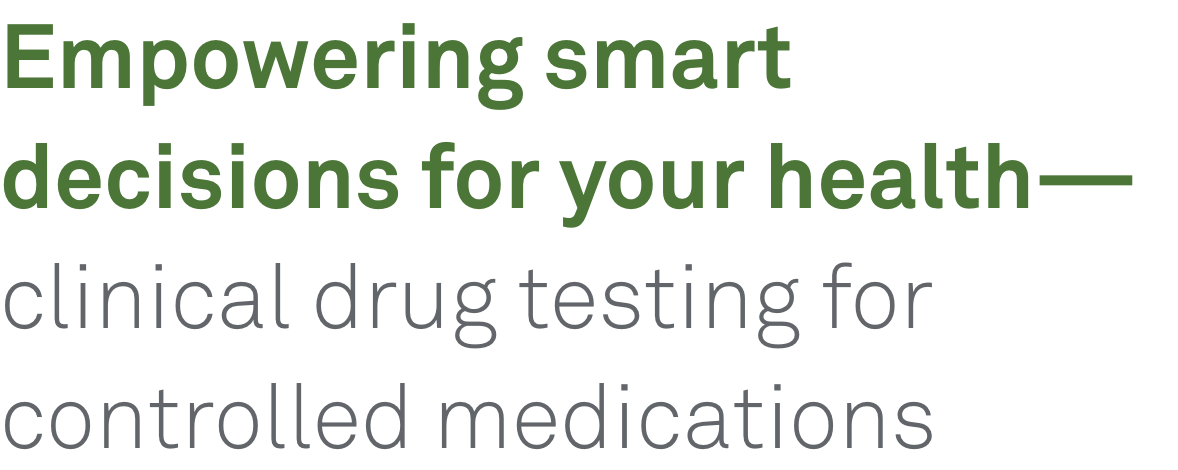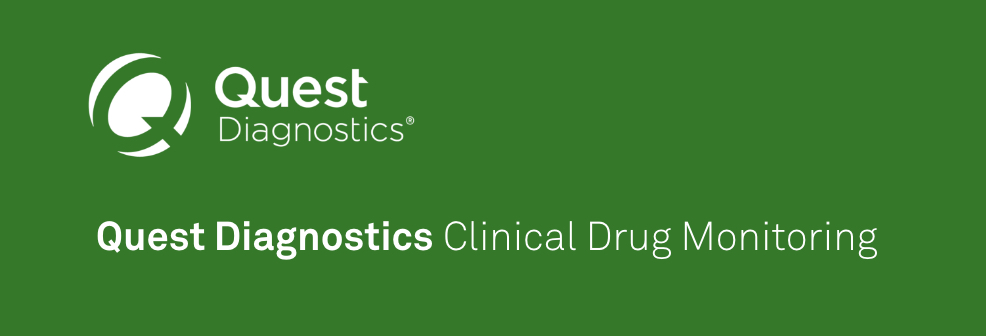

|
|
Physical dependence on the drug |
|
|
A potential to misuse the drug |
|
|
Harmful interactions with other medications |
|
|
Did you know?Data from the Quest Diagnostics database shows that as many as 1 in 2 patients show evidence of misuse in their drug test results. Some patients misuse their medication and don’t know it. Others may not understand the risks involved with medication misuse. That’s why testing can help keep you safe. |
Presumptive and definitive drug testing
Presumptive drug testing
- Presumptive tests identify possible use or non-use of a drug. They are initial screens conducted in the laboratory or on-site with a point-of-care test cup
- Presumptive tests may cost less than definitive tests and may produce results faster, but they have a higher cutoff—or detect at a higher level of drug concentration
- Presumptive testing often has decreased sensitivity and specificity when compared to definitive testing, which leads to false-negative and false-positive results
- If your presumptive test shows that there may be a medication misuse issue, your doctor may have your specimen sample tested again via another drug testing method, which is called definitive drug testing
Definitive drug testing
- Definitive tests are more accurate than presumptive tests as they detect at a lower concentration. They can identify patterns of misuse presumptive tests might miss
- Definitive testing has high sensitivity and is used to confirm or refute presumptive test results and reduces the occurrence of false-positive/false-negative results
- Definitive tests are performed in advanced laboratories, so they may take longer to produce a result and they may be more expensive
Medical and public health organizations recommend clinical drug testing
If you have chronic pain, opioid medications may be an important part of your treatment plan. The CDC and the American Association for Clinical Chemistry (AACC) Academy both recommend that you get tested before starting opioid therapy, and that you get tested 1-2 times per year while you are taking your medications.1,2 Higher-risk patients may need to be tested more frequently.2
The American Society of Addiction Medicine (ASAM) recommends that drug testing be a routine part of your care in all addiction treatment settings.3

Clinical drug testing for safe, effective patient care
We know many patients rely on controlled medications as part of their care. A drug testing protocol can help provide you access to the medications you need, while keeping you, your families, and your community safe.
Here are some of the many reasons we support clinical drug testing:
 |
Only source of objective information on how you are using your medication |
 |
Spots potential problems and helps minimize risks |
 |
Recommended by medical guidelines |
 |
Laboratory testing provides actionable information to help your healthcare provider make the right decisions for your care |
Frequently asked questions
Controlled medications are different from other types of prescription drugs. They come with risks of physical dependence, the potential for misuse, and harmful interactions with other medications. Clinical drug monitoring can help protect you from these dangers.
Testing provides information on what prescribed and non-prescribed drugs are in your system. The CDC guidelines encourage clinicians to monitor patients who take controlled substances, such as: prescription pain medicine (eg, opioids, such as Percocet® and OxyContin®; antianxiety medicines, such as Valium® and Xanax®; and certain ADHD medications, such as Adderall®). Clinicians may perform a urine drug test before prescribing an opioid, or other controlled medication, and may also test during treatment.
Patients prescribed a controlled substance may be asked to conduct a drug test by their clinician. For example, a baseline urine drug test is recommended for any patient who is:
- Starting chronic opioid therapy or another controlled medication
- Already prescribed opioids when they visit a new clinician
- Undergoing a major change in their medication treatment plan
- Drinks alcohol
- Has a history of or exhibits a substance use disorder
Urine is the preferred sample for drug testing. If you are unable to provide a urine sample, your clinician may be able to take an oral fluid sample.
There are different ways drug testing can be performed. There are some rapid screening tests that can be done in your clinician’s office, similar to a rapid strep test, but these point-of-care tests are not always as sensitive as clinicians would like. For example, in-office tests may not be able to detect every type of medication and can, on occasion, provide misleading results known as false-positive or false-negative results. In most cases, a patient can provide a urine sample at the clinician’s office. The clinician will send the sample to a laboratory, or you can visit a laboratory collection facility to give a urine sample. Your healthcare provider will get a report with your results.
Clinical drug monitoring is used to monitor use of certain prescription medications that carry risks if not used as instructed. These tests can also identify the use of additional medications, as well as illicit substances, that you may be taking that could pose a danger to your health or treatment plan. Sometimes patients do not realize that they are not using their medications the way they are prescribed or that they are increasing certain health risks. For example, combining a prescribed opioid with alcohol or an antianxiety pill (eg, Valium® and Xanax®) could lead to an overdose.
Typically, low-risk patients are advised to have a drug test done before starting opioid therapy, and then you may get tested once a year. When you are on chronic opioid therapy or using controlled medications, your clinician may use clinical drug monitoring as part of your treatment plan, and you may take a test more often.
Not necessarily. The best thing to do is to wait for your clinician to review your drug monitoring results. Then, together you can discuss any concerns.
Medication adherence, sometimes called medication compliance, refers to how a person follows the advice of their doctor and/or pharmacist when prescribed a medication, such as how much of a particular drug to take and when to take it.
When living with a chronic condition, such as chronic pain, long-term treatment plans are common, and it is your doctor’s role to monitor that plan to ensure that you move toward a positive outcome and that you do so in a safe manner. Therefore, medication adherence also includes looking at how well a person follows a prescribed treatment regimen over time.
Nonadherence can mean taking more medication than prescribed, skipping one or more prescribed doses, or stopping a medication early, that is, before your prescription runs out. For example, some people may not finish a 10-day antibiotic prescription because they feel better on Day 7; however, taking the full course of the 10-day prescription is necessary to ensure that any bacterial infection has left the body.
Drugs and other substances that are considered controlled substances under the Controlled Substances Act (CSA) are divided into 5 schedules (I-V). Substances are placed in their respective schedules based on whether they have a currently accepted medical use in treatment in the United States, their relative abuse potential, and likelihood of causing dependence when abused.
Many pain, sleep, and stimulant medicines are considered controlled substances and therefore are subject to abuse and misuse. Some examples of prescribed controlled substances include oxycodone, Valium, and methylphenidate (Ritalin®).
If you skip doses or do not stick to your prescribed treatment plan, this will affect the outcome of your illness, condition, or overall health. For example, many medications are short-acting and require that you take them on a schedule to maintain their levels in your system. Others are longer acting and can accumulate in your system—especially if you take more drug than prescribed by your doctor. When it comes to pain medications, most healthcare providers will have you sign a treatment agreement showing that you understand the risks of not adhering to the specific instructions with each medication. In fact, deaths have occurred by taking too much medication, or combining a medication with alcohol, other prescribed controlled substances, or illicit drugs.
In fact, approximately 125,000 people with treatable diseases die each year in the US because they do not take their medication as prescribed. Others may end up being admitted to a hospital or nursing home because they do not start or complete their prescribed treatment plans.4,5
Drug interactions occur when 2 medications or substances are consumed at the same time and interfere with each other. Some foods can interfere with the way your medications work as well. It is very important to pay attention to the instructions and warnings on your prescription label, and be sure your doctor and pharmacist know all the medications you are taking. This includes any supplements, vitamins, or recreational drugs you may be using. In some cases, 1 drug may weaken the effect of another drug. In other cases, taking 2 drugs together that are not meant be taken together could cause unwanted, and even dangerous, side effects. Sharing information on how much alcohol you consume is also important as there can be related side effects.
If you are prescribed a controlled substance, such as an opioid, your doctor will ask you to undergo drug monitoring. When it comes to medication adherence, your doctor may ask you to:
- Fill out a questionnaire about your prescription use
- Ask you questions about how you use your prescriptions and how the medication is working—such as whether your pain levels have decreased or if the prescription is helping you to engage in more regular daily activities
- Use a pill counter and/or calendar or journal to help track when you take your medications and to help you plan when your next refill is due
- Use a device or app to track your activity—especially if exercise is part of your treatment plan. Even a low level of exercise is recommended to help manage many chronic conditions
- Sometimes, your doctor may ask one of your family members or caregivers to help you monitor your prescriptions to ensure that you remember when to take them or to share information on how the medication seems to be helping you
Overall, this type of feedback can provide your doctor with a full picture of how the treatment plan is working and help in making any necessary adjustments.
All prescribers now have access to internet-based Prescription Drug Monitoring Programs that show when and where you fill your controlled substance prescriptions. You should expect that someone from your doctor’s office will check these sources frequently to monitor your compliance. Prescribers will also ask you to undergo intermittent drug testing to make sure that you are adhering to your medication regimen and not consuming any other drugs or substances that may increase the risk of your treatment.
Contact us
- CDC. CDC guideline for prescribing opioids for chronic pain—United States, 2016. Updated March 18, 2016. Accessed August 13, 2021. https://www.cdc.gov/mmwr/volumes/65/rr/rr6501e1.htm?CDC_AA_refVal=https%3A%2F%2Fwww.cdc.gov%2Fmmwr%2Fvolumes%2F65%2Frr%2Frr6501e1er.htm
- American Association for Clinical Chemistry(AACC). Langman LJ,Janetto PJ, eds. Using Clinical Laboratory Tests to Monitor Drug Therapy in Pain Management Patients. AACC Academy; 2017. Accessed August 13, 2021.https://www.aacc.org/-/media/Files/Science-and-Practice/Practice-Guidelines/Pain-Management/LMPGPain-Management20171220.pdf?la=en&hash=19670524407619F78999AB60731A24CB4901939D
- Jarvis M, Williams J, Hurford M, et al. American Society of Addiction Medicine (ASAM) Consensus statement: Appropriate use of drug testing in clinical addiction medicine, consensus statement. J Addict Med. 2017;11(3):163-173. doi: 0.1097/ADM.0000000000000323
- Sabate E, ed. Adherence to Long-term Therapies: Evidence for Action. World Health Organization; 2003. Accessed August 13, 2021. https://www.researchgate.net/publication/318679616_ADHERENCE_TO_LONG-TERM_THERAPIES_Evidence_for_action
- American College of Preventive Medicine. Medication Adherence Clinical Reference. ACPM; 2011. Accessed August 13, 2021. https://cdn.ymaws.com/acpm.site-ym.com/resource/resmgr/timetools-files/adherenceclinicalreference.pdf

